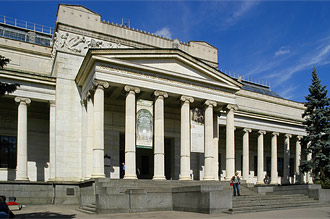 |
 Paintings, sculpture and applied art from ancient history to the present day - art fans can find all this and more at the Pushkin Museum.
Paintings, sculpture and applied art from ancient history to the present day - art fans can find all this and more at the Pushkin Museum.
The museum's greatest treasures are to be found in its collection of European art from 1600, particularly the perennially popular and vastly comprehensive collection of French impressionists and post-impressionists, which comes close to that of the Musee d'Orsay in scope. Also of note are the display of Schliemann's "Troy treasure", removed from Berlin at the end of the war and probably dating from the late Bronze Age; a small collection from ancient Egypt; and rooms full of plaster casts of the most important sculptures from the Hellenistic era until the Renaissance.
While the museum lacks some of the contemporary gloss of its Western counterparts - there is no guide book at present, even in Russian, many of the exhibits appear never to have been cleaned, and the lighting and decor are old-fashioned to say the least - there is more than enough substance in the huge collection to make up for any superficial inadequacies. Underfunding and resistance to change also mean that, while a little shabby, the Pushkin is a considerably more peaceful place to contemplate great art than many of the more hyped and hectic big galleries in the West.
The museum is constantly altering its permanent display, which gives the public the chance to see more of the enormous collection, but can also be a little frustrating if you are coming to see a particular picture that has been inexplicably moved. There are also regularly changing temporary exhibitions, which often include collections from abroad. And, next to the main building, at Volkhonka 14, there is the Museum of Private Collections, purpose-built and opened in 1994, and housing mostly Russian art of the late 19th and early 20th centuries.
Opening hours: Tuesday to Sunday - 10:00 to 18:00, closed on Mondays.
|
 |

 Paintings, sculpture and applied art from ancient history to the present day - art fans can find all this and more at the Pushkin Museum.
Paintings, sculpture and applied art from ancient history to the present day - art fans can find all this and more at the Pushkin Museum.